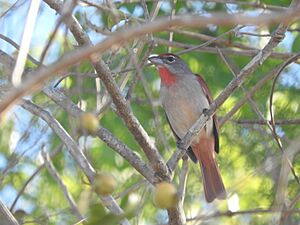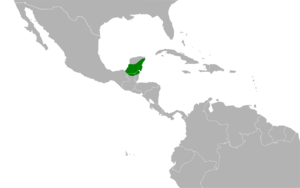Rose-throated tanager facts for kids
Quick facts for kids Rose-throated tanager |
|
|---|---|
 |
|
| Conservation status | |
| Scientific classification | |
| Genus: |
Piranga
|
| Species: |
roseogularis
|
 |
|
The rose-throated tanager (Piranga roseogularis) is a beautiful medium-sized songbird. It belongs to the Cardinalidae family, which includes cardinals and grosbeaks. This special bird lives only in the Yucatán Peninsula in Central America. You can find it in Belize, Guatemala, and Mexico.
Male rose-throated tanagers have grey feathers with a bright rose-colored throat and the top of their head. Female birds look similar, but their throat and crown are yellow instead of rose.
Contents
About the Rose-Throated Tanager
How Scientists Named This Bird
An American bird expert named Samuel Cabot III first described the rose-throated tanager in 1846. He saw these birds in the Yucatán Peninsula.
For a long time, the rose-throated tanager and other birds in its group, Piranga, were thought to be part of the "true" tanager family (Thraupidae). But around 2008, scientists learned more about their family tree. They found that these birds actually belong to the Cardinalidae family, which is where they are now.
Scientists also use special studies, like looking at mitochondrial DNA, to understand how birds are related. A study in 2019 showed that the rose-throated tanager is an early relative of other colorful tanagers. These include the scarlet tanager, hepatic tanager, summer tanager, western tanager, and flame-colored tanager.
Different Kinds of Rose-Throated Tanagers
There are three recognized types, or subspecies, of the rose-throated tanager:
- Piranga roseogularis roseogularis (the main type)
- P. r. tincta
- P. r. cozumelae
What Does the Rose-Throated Tanager Look Like?
The rose-throated tanager is about 16 cm (6.3 in) long. It weighs between 21 to 30 g (0.74 to 1.06 oz), which is about as much as a few quarters.
Male and Female Colors
The main type of male tanager has a deep rose color on its head and throat. The rest of its body is different shades of gray. When its wings and tail are folded, they look crimson, which is a deep red color.
Female tanagers have a yellow head and throat. Their upper body feathers are yellowish-olive, and their belly is mostly light gray to whitish. Their folded wings and tail are yellowish.
Subspecies Differences
- P. r. tincta looks like the main type but has lighter colors.
- P. r. cozumelae is darker than the other types.
Where Does the Rose-Throated Tanager Live?
The rose-throated tanager lives in different parts of the Yucatán Peninsula.
Habitats of Each Subspecies
- The main type, Piranga roseogularis roseogularis, lives in the northern, drier part of Mexico's Yucatán Peninsula.
- P. r. tincta lives in the more humid southern part of the peninsula. It also lives in northern Guatemala and Belize.
- P. r. cozumelae is found only on the islands of Mujeres and Cozumel. These islands are off the east coast of the peninsula.
Preferred Environment
These birds mostly live at the edges of semi-humid and humid forests. They also like the thick undergrowth of scrubby forests. Sometimes, they can be found in areas with just scrub and a few scattered trees. They live from sea level up to about 250 m (820 ft) high.
How the Rose-Throated Tanager Behaves
What Do They Eat?
The rose-throated tanager looks for food at all levels of the forest. It searches in the undergrowth, on small trees, in the middle parts of the forest, and even high up in the treetops. When it's in the canopy, it often joins groups of different bird species that are foraging together. These birds have also been seen following army ant swarms, which stir up insects they can eat. Scientists don't have a lot of detailed information about their exact diet yet.
Vocalizations: What Do They Sound Like?
The rose-throated tanager has a rich, warbling song. It sounds like "whee chee cheer-el-chee cheer-el-cheu chee-el-chu..." They also make calls that sound like a nasal "rreh" and a soft, mewing "myaaa."
Conservation Status
The IUCN (International Union for Conservation of Nature) has evaluated the rose-throated tanager. They have assessed it as a species of "Least Concern." This means that even though some parts of its home are affected by human activities, the bird does not seem to be in immediate danger.


